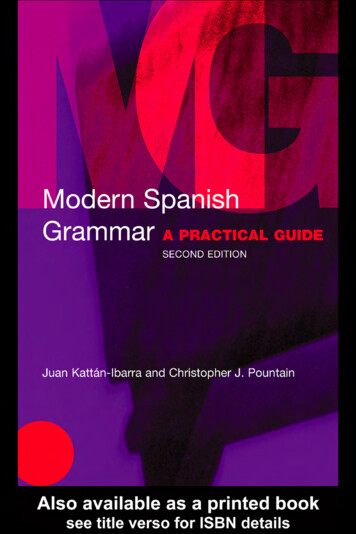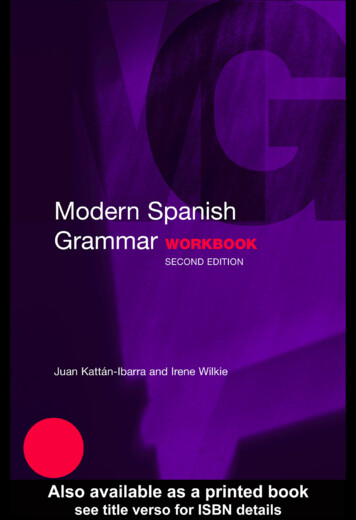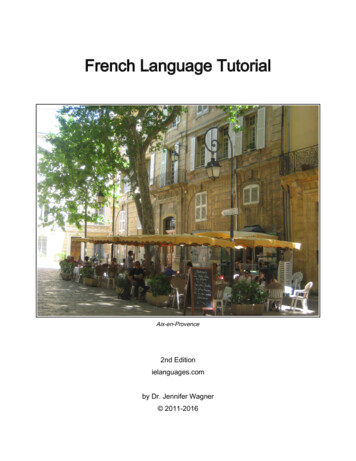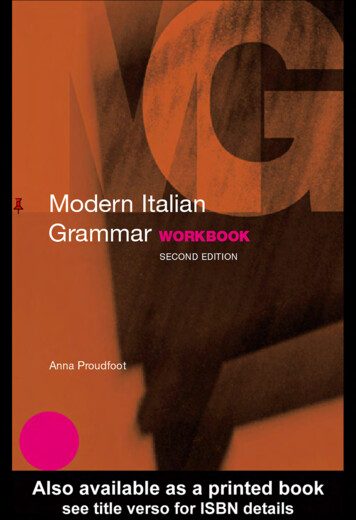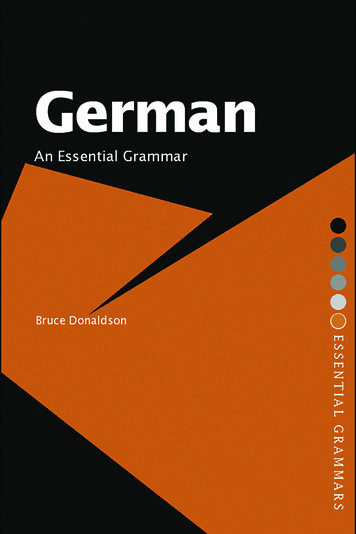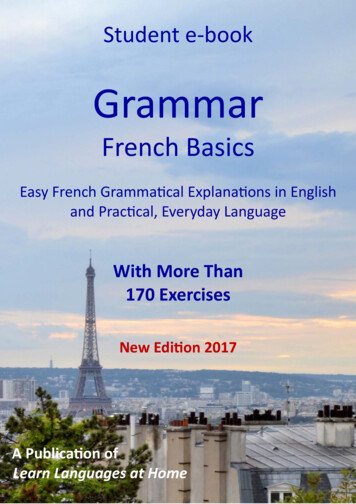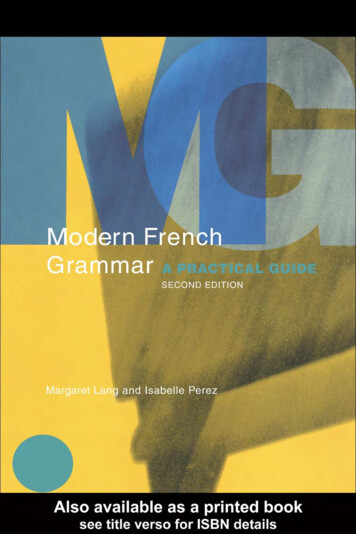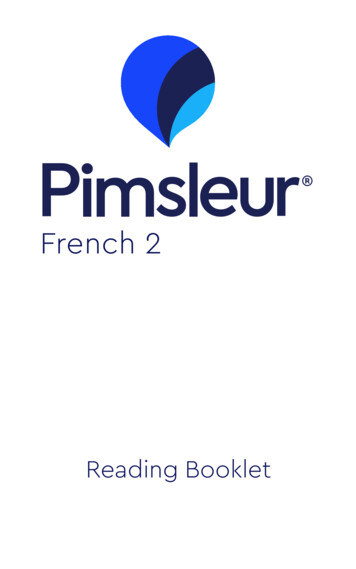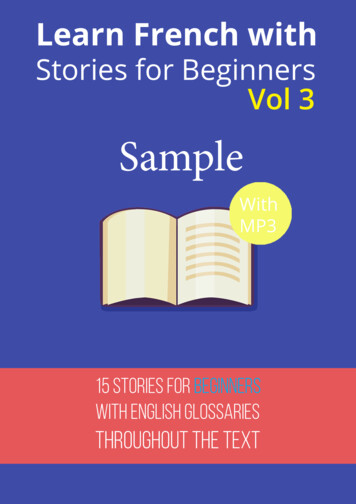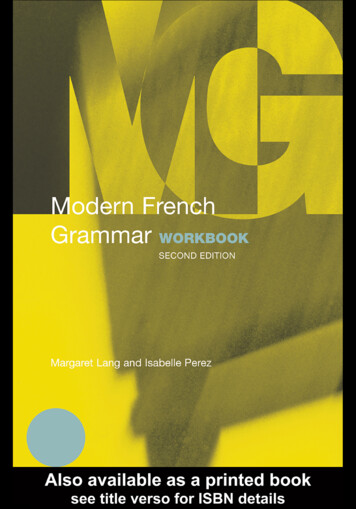
Transcription
ModernFRENCHGrammarWORKBOOKSecond Edition
Routledge Modern GrammarsSeries concept and development – Sarah ButlerOther books in series:Modern French Grammar, Second Edition by Margaret Lang and Isabelle PerezISBN: HB 0–415–33482–9; PB 0–415–33162–5Modern German Grammar, Second EditionModern Italian GrammarModern Spanish Grammar, Second EditionModern German Grammar Workbook, Second EditionModern Italian Grammar WorkbookModern Spanish Grammar, Second Edition
ModernFRENCHGrammarWORKBOOKSecond EditionMargaret Langand Isabelle Perez
First published 1997by RoutledgeThis edition first published 2004by Routledge2 Park Square, Milton Park, Abingdon, Oxon OX14 4RNSimultaneously published in the USA and Canadaby Routledge270 Madison Ave, New York, NY 10016Routledge is an imprint of the Taylor & Francis GroupThis edition published in the Taylor & Francis e-Library, 2005."To purchase your own copy of this or any of Taylor & Francis or Routledge'scollection of thousands of eBooks please go to www.eBookstore.tandf.co.uk." 2004 Margaret Lang and Isabelle PerezAll rights reserved. No part of this book may be reprinted orreproduced or utilised in any form or by any electronic,mechanical, or other means, now known or hereafterinvented, including photocopying and recording, or in anyinformation storage or retrieval system, without permission inwriting from the publishers.British Library Cataloguing in Publication DataA catalogue record for this book is available from the British LibraryLibrary of Congress Cataloging in Publication DataA catalogue record is not needed for this title as it is expendable educational materialISBN 0-203-39726-6 Master e-book ISBNISBN 0-203-67130-9 (Adobe eReader Format)ISBN 0–415–331–633 (Print Edition)
ContentsAcknowledgementsIntroductionSection A Structures1IThe noun group3IIThe verb group13Section B Functions37III Exposition39IV Attitude53V57ArgumentationAnswer keyCross-references to Modern French GrammarIndex of grammar structuresIndex of functionsvviiix68939597
AcknowledgementsThe authors would like to thank the following for their permission to reproduceextracts from copyright material: L’Evénement du jeudi no. 560, 27.7–2.8.95 (p. 41ex.81); Office des publications officielles des Communautés Européennes for Le Marchéunique européen, L’Europe en mouvement (p. 5 ex.5) and Notre Avenir agricole (pp. 34–5ex.73), Luxembourg 1993; also for Eurobaromètre 40 in L’Intégration européenne, ‘LesOrigines et la croissance de I’UE’ (p. 46 ex.91), Luxembourg 1995; La CommunautéEuropéenne – 1992 et au-delà (p. 65 ex.135), Luxembourg 1991; La Recherche socioéconomique (p. 35 ex.74), Luxembourg 2002; L’Aéronautique en Europe (p. 35 ex.74),Luxembourg 2002; Surveillance planétaire de la sûreté environnementale (p. 36 ex.74),Luxembourg 2003; Journal Officiel des Communautés Européennes for Débats duParlement européen 18.11.93 (p. 5 ex.6); Ambassade de France à Londres for ‘France,A journalist’s guide 1995’, 6th edition (pp. 48–9 ex.97); Fédération des AssociationsFrançaises en Grande-Bretagne for Français de Grande-Bretagne, Eté 1995 (pp. 15–16ex.27); 1994 by Matt Groening. All rights reserved. Reprinted by permission ofHarperPerennial (pp. 51–2 ex.103); PSA Peugeot Citroën for Rapports annuels 1991and 1994 (p. 64 exs 129/130); C. Guiat, Heriot-Watt University, Edinburgh 1996(p. 65 ex.133).vii
IntroductionThis workbook is designed to provide practice in the essentials of French grammar andin the application of grammar to functions. It will be of use to the student in the finalyear of school and the student in first, second and final years of higher education.Intermediate and advanced learners will find much that is useful for extending theirknowledge of French, and for revision. Written initially as a companion volume toModern French Grammar, the workbook has developed independently of its sistervolume and can be used successfully on its own. It contains a key, which will enablestudents to work by themselves. The order of functions in this workbook follows closelythe order of functions in Modern French Grammar. It is recommended, therefore, thatreference should be made to Modern French Grammar for guidance on both grammarstructures and functions.FunctionsModern French Grammar is a functional grammar, that is, it demonstrates how to dothings with language in order to communicate successfully. The functional categoriesare identified, very broadly, as exposition, attitude and argumentation. Expositioninvolves reference to people, things and places; narrating events in a sequence;reporting what we, or other people, say or think. Attitude involves the personal,subjective part of language which is evident when we are expressing our feelings, whenwe are reacting to someone or something. Argumentation, finally, is a broad functionincluding planning and structuring what we say or write, involving the use of languageto influence people in some way – for example, when we agree or disagree, concede apoint, correct or protest, suggest or persuade, when we talk about what we want to do orwhat we want other people to do, when we express doubt or opposition . . .Forms and functionsIt is not always desirable, or even possible, to attach a form to a function, or a functionto a form. For one thing, there is seldom an exclusive link between the two. But, inmany cases, it is possible to identify a correspondence between the form and thefunction, for example, adjectives and describing, si clauses and the expression ofconditions/possibility.ix
INTRODUCTIONExercises, contexts, vocabulary and keyWe have given a very wide range of exercises and a very wide range of contemporarycontexts. We encourage both written and oral responses, involving vocabulary that isin frequent use and vocabulary which we consider will be a useful addition to students’resources. For the grammar exercises complete answers are provided, for the functionswe provide guidelines (suggested answers), and we would encourage flexibility instudents’ responses. In these suggested answers, care has been taken to guide and assistthe user.To the teacherThis workbook is intended for intermediate and advanced learners in schools and forundergraduates. Students may work individually, in pairs or groups, in class and athome. There is a key which will facilitate whichever of these learning situations is inpractice. The workbook contains exercises in grammar structures and in functions.Each exercise is classified in terms of level: (*) basic, (**) intermediate, (***) advanced.Practice in grammar structures includes gap-filling, but, instead of focusing on thesame or on a limited number of forms in one exercise, for example, the basic trio qui,que, dont only, we have extended the range to include prepositions relativepronouns; or in the case of tense usage, we have ensured that either a range of tenses ispractised in one exercise, or that the context has to be understood before a decision ontense choice can be made.Transformation exercises include the changing of direct to indirect speech; active topassive moods; and infinitives to imperatives.Practice with forms is also included, involving, for example, giving singular andplural forms; forming adverbs from adjectives; making sure that subject and verb agree;and using negative forms.We have attempted to ensure that exercises require attention to one or more of thefollowing: context, collocation and register, and to oral and written forms.Revision exercises involve practice of several grammar structures, and we haveincluded passages for translation involving practice in all the grammar structures.You will find some of the exercises ideal for your French assistant/s to use.Practice in functions is distinguished from practice in grammar structures in the highlevel of contextualisation which has been a guiding principle throughout thepreparation of the book. Each function exercise has a context or setting such associal, business, educational. Within these contexts, students are asked to describepeople, things or places; introduce people to each other; give directions; expressfeelings; argue a case; express opposition; link statements logically; structure text,and so on.In order to practise the functions, many innovative exercises have been created inwhich students may be asked to respond or react to a controversial statement; assumeone of the roles in a dialogue; negotiate a pay rise; write a notice or advertisement;identify several functions of a grammar structure; state conditions or hypotheses;correct statements or views; or develop a full, coherent text from notes.x
IntroductionIn addition, there are more familiar forms of exercises involving gap-filling, problemsolving, comparing and contrasting.Frequently, in the function exercises there is an explicit request for a written or oralanswer. Where the instruction does not specify one or the other, we recommend thateither, or both, may be practised.To the studentIn this book you will have an opportunity to practise a range of grammar forms andfunctions. French grammar really does have a purpose and it does need to be accurate.Accuracy is the hallmark of a competent and committed user of French.As far as the functions go – and by functions in language we mean the things youneed language to do for you – we have classified them to cover most of the functionsyou will need when you are living in France, speaking or writing to French people,conducting business transactions with them, and so on. Of course, if you can do thesewith the French you will also be able to do them with the Belgians, the Swiss, theCanadians. . . .You need the grammar structures and you need the functions; they are inseparableand they are both very, very useful. The number of each exercise is followed by*, **,or ***. These asterisks indicate whether the exercise is basic (*), intermediate (**), oradvanced (***). You can start by working through all the basic exercises, continue atyour own pace through the intermediate exercises, and finally move on to theadvanced ones.There is a key to the exercises, so that you can work by yourself – you do not have to bein the classroom. But, you will need your teacher for explanations: your questionsreflect your individual needs, and your teacher can help you here. The key is providedas a guide only: there is seldom one single answer that is the only correct one in alanguage in use. Where a complete answer is not given, this is because we are askingyou to use your own resources and knowledge – and you have much more French thanyou think.You will find a wide variety of exercises in this book. Enjoy yourselves!xi
Section AStructures
IThe noun group1 / This exercise practises articles.(i) Write the following sentences in the singular:1234Les étudiantes étaient ravies des résultats de leurs examens.Ils sont allés chercher des dictionnaires d’italien.On a trouvé des prȯfs en train de discuter des films de Tavernier.Y avait-il des bouteilles de vin sur leurs bureaux?(ii) Make the following sentences plural:Example: Elle s’est servie d’une nouvelle recette. Elles se sont servies denouvelles recettes.1234567891011121314152 / Il a oublié d’obtenir un double de son permis de conduire.Il se souvient du numéro de téléphone.Elle a appliqué cette méthode à son entreprise.Je m’occupe du chien de mon beau-frère quand il est en France.C’était une prof sympathique.Elle a mangé un petit pois; elle en est malade!Y a-t-il un nouveau film au Centre Pompidou cette semaine?Elle a un petit ami français.Je réponds toujours immédiatement à une lettre de réclamation.Elle a emprunté un livre à la bibliothèque.Je me suis trompé de nom.Cette bicyclette appartient au petit garçon.Le gouvernement au pouvoir a des préjugés contre la famille monoparentale.Un bénévole ne tardera pas à venir.Sa table sert de bureau.This exercise practises articles.Fill in the gaps in the following sentences. Remember: there are contracted forms of thearticles when they are preceded by à or de.12343Parisprintemps, etcampagnemois de septembre.Il vaAs-tu vu les pyramidesEgypte?Non, mais j’observe toujours une minutesilence avant de manger!Elle s’est renduetravail, et lui est alléécole pour trouver son livreanglais.
STRUCTURES5 C’est une dame ravissante,cheveux blonds etla silhouettevoixsensationnelle. Dommage qu’elle soit si désagréable, une vraie mégèreidées étroites!stridente et6 Il faut faire réparer le toitmaison.7 Y a-t-il eupluie?vent.8 Non, mais il y a eu9 Que penses-tugouvernementFrance?10 Pas grand’chose, mais je prendrai volontiersverre.11 Tu veuxbière,eau, ouvin?12 Nous, on ne boit jamaisvin.13 Moi, je ne veux pasvin maiseau.14 Tu es l’étudiante préféréeprof!1362 kmlong et376 kmlarge jouit15 Cette péninsuleimpressionnante diversitémilieux naturels, et aussiflore trèsSyrie, etGrèce. On y trouveriche. Elle partage ses frontières avecmontagnes, surtoutcentre etest,plateaux,tout:plaines, et aussitrès belles plages.3 Use à, au, à l’, à la, aux, avec, and avoir and être, to make sentences with the followingwords and phrases:1 ma voisine/la trentaine/cheveux châtain clair/yeux verts immenses/grande/taillefine/toujours souriante/serviable et généreuse/clerc de notaire2 le directeur du supermarché/pas très grand/barbe abondante et petites lunettesrondes/cheveu rare et oreilles décollées/prétentieux et agressif3 Now describe your lecturer, and submit your work for assessment.4 / Insert the appropriate possessive pronouns or adjectives, or definite articles, in thefollowing sentences:yeux, il faut glisser sousnuque une serviette roulée,1 Pour se reposeryeux et faire le vide danstête pendantposer une compresse surdix minutes. Un autre bon moyen de se relaxer consiste à se masserpieds.2 Il paraît que nous utilisons à peine 20% decapacités pulmonaires. En outre,muscles se contractent,dos se raidit et noussous l’emprise du stress,gaspillons de l’énergie inutilement.3 Vous devez prendre du recul par rapport àactivité professionnelle et parfois,problèmes sur lesquels vous ne pouvez pas agir. Acceptezlaisser tomberenfants passent par des moments où ils ne sont pas heureuxégalement quefaute.et que ce n’est pas systématiquement4 Les agences matrimoniales promettent àclients de mieux poserdemande et surtout, de déterminer les caractères compatibles avec.5 Inutile de continuer à me casseroreilles, tu asopinion et moi,!6 Si vous êtes d’accord pour faire un échange, nous accueilleronsenfants en(Patrick et Clara) en août.juillet et vous prendrez7 Tu n’as vraiment aucune raison d’être déprimé:filles réussissentmétier te passionne,livres se vendentbrillamment et sont heureuses,4
The noun groupbien, beaucoup mieux que; d’ailleurs, c’est plutôt moi qui devrais leverbras au ciel en gémissant!Now translate the examples into English.5 This exercise revises articles, pronouns, and demonstrative and possessive adjectives.Complete the following text:intérêt pourEurope,Communauté aliensA côté devoisins méditerranéens ainsi qu’avecTierstraditionnels avecpays se tournent verspourdemanderMonde.coopération etappui financier.pressionimmigrants enSud etEst pourrait uté.(Le Marché unique européen, L’Europe en mouvement Office des PublicationsOfficielles des Communautés Européennes, Luxembourg, 1993)6 / This exercise practises relative pronouns.Remember: there are simple forms qui, que, dont, lequel, où, and compound forms cequi . . .Fill in the appropriate relative pronouns and adjectives in the following text:veut se maintenir à tout prix. Le régime a ratifié deuxC’est une dictatureon signe etpactes internationaux relatifs aux droits de l’homme. Mais, entreon réalise il y a souvent un fossé. Le leader de notre parti,est unon respecte beaucoup, a souvent fait des déclarations sur lehomme habile etrespect des droits de l’homme. Eh bien! Ce sera la violation des droits de l’hommenous interviendrons à cette réunion. Notre groupe a toujoursau sujet deque soit ce terrorisme,quedénoncé toutes les formes de terrorisme,soient les victimes. Aussi invitons-nous la Communauté européenne à prendre despermettent d’assurer la sécurité du territoirenos citoyensmesureson aont tellement besoin. Nous avons été fort déçus par la déclarationmontre qu’en réalité nos pays ne sont pas prêts à assumerentendue hier ettoutes leurs responsabilités. Nous demandons qu’une décision définitive au sujetde la date des élections soit prise de toute urgence. Mes chers collègues, c’estnous demandons. Merci de votre attention!(Parlement européen 18.11.93)7 Add a relative pronoun to the following sentences, and, where appropriate, apreposition or a prepositional phrase:Example: Certaines des questions . . . il fallait répondre étaient carrémentinsolubles. Certaines des questions auxquelles il fallait répondreétaient carrément insolubles.12345675nous vous avons prêtés.Rapportez-nous les livresil pense est morte il y a deux mois.La dameil avait demandé des conseils lui a envoyé d’abord une note à payer.L’avocatnous nous sommes échappés a été fermé au verrou.Le soupirailtu as parlé si impoliment est ton nouveau chef de section.L’hommeje suis allé à l’école.Je suis marié à la fille de mon ancien professeurMontre-moi le sentiertu es passé.
STRUCTURES8 Le disque laser9 Le bruit courtannée!8 mes frères ont écouté toute la nuit m’a rendu malade.nous allons avoir une énorme augmentation de salaire cettePut the phrases in italics into the appropriate place in the following sentences:Example: La maison est charmante. où j’habite La maison où j’habite estcharmante.1 C’est un mot dans le dictionnaire. qu’on ne trouve pas2 Les réponses n’étaient pas bonnes. qu’elle a données3 L’étudiante est la plus belle de la classe. dont je t’ai donné l’adresse et le numéro detéléphone4 Le médecin est un jeune homme très gentil et toujours très poli. qui est venu cematin5 Le prof nous a offert des conseils en ce qui concerne notre année en Angleterre.que nous négligeons à tort6 Ce journal ne vaut pas le papier sur lequel il est écrit. dont chaque page ne contientque des images.9 / This exercise practises personal and emphatic pronouns.(i) Replace the phrases in italics with one or more appropriate pronouns. Remember:pronouns have to be in their correct position in the sentence, and in their correctorder.Example: On n’a jamais raconté des histoires comme ça aux enfants. On neleur en a jamais raconté.1234Donne le livre à l’étudiante!Elle essayait d’expliquer sa panne de voiture aux mécaniciens.Doit-il aller à la banque aujourd’hui?N’allez pas répéter ces mots à la prof!(ii) Replace the words and phrases in italics with pronouns. Turn each sentence into apositive imperative and then make it a negative imperative.Example: Vous emprunterez de l’argent pour acheter des billets. Vous enemprunterez pour acheter des billets. Empruntez-en pour acheterdes billets./ N’en empruntez pas pour acheter des billets.12345678 10 / Tu t’assieds.Vous posez des questions maintenant.Tu manges du pâté.Vous vous brosserez les dents avant de vous coucher.Nous nous arrêtons.Tu donnes ton numéro de téléphone à ton amie.Vous prendrez vos impers.Tu demanderas des conseils à tes profs.Each of the following pronouns has two different functions (see examples 1 and 2):des siennes; les siens; la vôtre; la tienne; aux miens; du nôtre. Write two sentencesfor each of them to demonstrate their different meanings.6
The noun groupExample: 1 Le fils de Jacqueline a encore fait des siennes et il est viré de pécolependant trois jours!2 Elle n’a jamais voulu me rendre service; alors je veux bien arrosertes plantes vertes pendant les vacances, mais pas question dem’occuper des siennes!Now do the same with la leur; les leur(s); le leur.Example: Je n’ai plus de voiture, alors ils m’ont prêté la leur.Je la leur ai empruntée.11 / This exercise practises demonstrative adjectives.Complete the following sentences with appropriate demonstrative adjectives.Remember: these adjectives may be simple (ce, . . .) or compound (ce noun -cior -là).exercice. Il est trop facile. Je déteste cet exercice.Example: Je détesteIl est trop facile.1234567On a vufilmsété.amis ne m’accompagnent plus au théâtre.Passez-nousverres.Ne lui posez jamaisquestion.Berk! Quelles sontodeurs répugnantes?paysagesme plaisent énormément.Sers-toi deautre livre. Ça facilitera la solution du problème.12 / This exercise practises demonstrative adjectives and pronouns.Complete the following sentences. Check exercise 11 for a reminder of the forms ofsimple and compound demonstrative adjectives. Demonstrative pronouns may also besimple (celui, . . .) or compound (celui-ci or celui-là, . . . and celui qui, que or dont).Don’t forget the little group ceci, cela, ça.123456789101112131415167entretien a eu lieu quand?CAlors, cbébé, cpousse?Chommeest le coupable.Chommesétaient innocents.Mes parents aimaient chôtel.Cn’est pas moi qui ai commis cerreur.Quelles chaussures as-tu achetées? Ctu parlais hier?C,cest à moi!Tous cne sont pas là feront la vaisselle demain.Cserait étonnant qu’il ait fait ses devoirs!Le vin, cfait du bien!Cn’a ni rime ni raison.Cest simple comme bonjour.Cse vend comme des petits pains.De tous les crimes commis ces dernières années, celle parle est le pire.Ne montre pas cphoto; ctu as prise il y a deux ans.
STRUCTURES17 Cest pour lui et csera pour elle.films que j’ai vus en vacances ne sont pas ctu parles.18 Cje me souviens des noms recevront un préavis de la campagne de19 Cvente.d’en face.20 Quel appartement? Cà venir!21 A tes réussites passées et à cdésirent avoir un lecteur de disques laser chez eux!22 Nombreux sont c23 La loi du 30 juin 1983 sur l’égalité professionnelle entre les hommes et les femmesdernières l’accès à tous les métiers, ainsi que des conditions dereconnaît à cdes hommes.recrutement, de travail et de rémunération identiques à cHélas! La réalité est souvent différente!24 Les Grandes Ecoles françaises sont carrément un club fermé! Beaucoup d’étudiants, ils doivent faire deux ans derêvent d’y être admis un jour. Pour cpréparation avant le concours destiné à sélectionner les meilleurs. 13 / This exercise practises pronouns and other parts of speech.(i) Rewrite the following text using the first person singular:Depuis qu’elle est partie, elle n’arrive pas à se décider. Ces pieds! Est-elle plus à l’aisedans la chaussure gauche ou droite? Voilà une heure qu’elle marche et qu’elle neregarde que ses pieds. Elle sait qu’avec ces chaussures Amini elle n’aura peut-êtrepas mal aux pieds, mais elle risque une sacrée migraine en les regardant toute lajournée!(ii) Rewrite the following text using the third person singular:Voilà mon CV. Je voudrais poser ma candidature aux présidentielles et je dois doncavoir plus de 23 ans. Je suis dégagé de mes obligations militaires. Je n’ai jamais étécondamné à la prison ni à un retrait de mes droits civils et politiques. Parfait! Ça yest! Hélas! Il me faut recueillir la signature de 500 élus dans 30 départementsdifférents. Sans cela on pourrait croire que ma candidature est bizarre!(iii) Would it make sense to write the above text in the feminine form? If not, why not?(iv) Rewrite the following text using the first person plural:Le vin, c’est pour moi une joie de vivre! Je trouve que c’est un élémentindispensable dans ma vie. J’apprécie les bordeaux, les chablis, les vins de la valléedu Rhône. Après les dîners qui ont marqué mon vingt et unième anniversaire, je neme souviens plus de ce que j’ai mangé mais je me souviendrai toute ma vie de ceque j’ai bu. Le vin ce jour-là, c’était comme un parfum exquis! Quand je l’ai senti jeme suis arrêté de parler. C’était, pour moi, un très grand moment! A vrai dire,quand je bois un verre de vin je trouve qu’il n’y a pas de mots pour décrire mesémotions!14 This exercise practises indefinite pronouns and adverbs.Complete the following sentences with an appropriate indefinite pronoun, or adverb(quelqu’un, quelque chose, quelques-un(e)s, on, quelque part). Some changes toother words may also be necessary.1 Chut! J’entends2fait ce que8dans l’escalier.peut.
The noun group345678910111213141515 Qu’est-ce quemange aujourd’hui?a vu mon professeur?Est-ce queC’estd’incroyable!ne fait pas d’omelette sans casser d’œufs.à ajouter?Tu asd’autre téléphone pendant mon absence, dites que je serai là cetSiaprès-midi.a tout notre temps.vous a prévenu. Ce produit lave plus blanc!.Elle a mangé presque tous les bonbons mais il en restene doit pas fumer dans ce restaurant!de ses pièces.Il va parler de.Où sont mes lunettes? Je les ai vuesqui sontTu aimes les vins d’Alsace? Oui et non, mais je n’en connais quebuvables.This exercise practises tout: adjective, pronoun and adverb.Say whether tout is an adjective, pronoun or adverb in the following sentences.Remember that adverbs are normally invariable, but when tout is an adverb it agrees ingender and number with the adjective following it – if the adjective is feminine andbegins with a consonant.12345678916 Continuez tout droit, tout droit!Tout ce qui reluit n’est pas or.Mes chaussures sont toutes mouillées.Les solutions possibles ont toutes été trouvées.Ecrire en toutes lettres.Parlez tout doucement!Tout est bien qui finit bien.Ma chère amie! Tu es toute bronzée!Toute autre femme aurait protesté contre cette décision.This exercise practises n’importe ( qui, quoi, lequel, que, où, quand, comment).Complete the following sentences with an appropriate indefinite pronoun, adjectiveor adverb:123456717 / Il est vraiment stupide. Il dit n’importe., même la nuit.N’hésitez pas à m’appeler n’importe. Pas de cérémonie!Habillez-vous n’importepeut y assister.Les cours sont publics. N’importetemps.Si on s’habille en conséquence, on peut sortir par n’importe.Ces jeunes gens jettent leurs ordures n’importeTu veux emprunter une de mes vestes pour sortir ce soir? Prends n’importeThis exercise practises autre, l’un l’autre.Using appropriate forms of autre, and the pair l’un l’autre, fill in the blanks in thefollowing sentences. Remember: you may need to insert a preposition between l’unand l’autre.9!
STRUCTURES1 J’ai trouvé quelques clefs, mais où?sont.2 Pardon! On t’a pris pour.3 Ils ont cessé d’être amoureux4 Elle ne sait pas laquelle de ses amies.l’a fait. C’est5 Certains ont voté pour Chirac.se sont abstenus.6 Ils ont emprunté de l’argent.7 lls sont tout à fait dépendants18 .8 Les deux sœurs s’aideront9 C’est Jacques ou Pierre? Tout faux,.ce n’estnon.10 Les uns disent oui,solution n’est possible.1112 Les deux livres étaient là,au-dessous de.13 Elles seront très fâchées14 Ils sont tous arrivés hier,un peu avant.This exercise practises adjectives.1 Make the following adjectives plural and then give the feminine singular form ofeach one: actif, français, blanc, européen, fier, traditionnel, beau, ce, long, complet,honteux, frais, grec, professionnel.2 Make the adjectives in brackets agree with their noun, if necessary: robes (marron),langues (anglo-saxon), (nu)-pieds, tête (nu), une (demi)-journée, 2 heures et(demi), pommes (aigre-doux), fleurs (frais cueilli), fenêtres (grand ouvert).3 Make the adjectives agree with their noun and then, if possible, with itscomplement: des joueurs de football (américain), une boîte de livres etdocuments (poussiéreux), un prof de grammaire (anglais), des amateurs de télé(allemand).4 Make the adjectives agree with the nouns in the following phrases: accents(méridional), accords (international), amis (loyal), responsables (local), conseils(municipal), chefs (départemental), droits (fiscal), désaccords (parental), chantiers(naval), secteurs (artisanal), salaires (inégal), systèmes (entrepreneurial), centres(provincial), chèques (postal), services (social), revenus (global), pactes (fédéral),contrôles (mondial), groupes (communal), codes (pénal).Practise saying all the nouns and adjectives so that you don’t forget the masculineplural form.19 This exercise practises adjectives and adverbs.1 Find the adjectives which correspond to the following adverbs: complètement,indûment, patiemment, précipitamment, soudainement, clairement, précisément,bruyamment, récemment, artificiellement, légèrement, nullement, incessamment,assidûment, sèchement.2 Three of the above group have two forms and these are usually found in differentcontexts, e.g. boire sec, répondre sèchement. Identify the two other adverbs inthe list which have an alternative form. Do they have to be used in differentcontexts? Check in a dictionary, and provide examples of them in use.3 Form adverbs from the following adjectives: doux, courant, modéré, conscient,fréquent, premier, vif, principal, exceptionnel.4 Find the negative forms of the following adjectives, e.g. régulier irrégulier:content, heureux, réalisable, pair, légal, typique, adroit, normal, semblable.5 The prefix in- suggests opposition or separation. Form adjectives from thefollowing infinitives, by adding in- at the beginning of the word, e.g. appliquer inapplicable: attendre, comprendre, connaître, contester, décider, défendre,douter, fatiguer, nier.10
The noun groupNow do the same by adding the prefix im- to the adjectives formed from the followinginfinitives, e.g. pénétrer impénétrable: prévoir, pouvoir, prononcer, produire, punir.20 / This exercise practises numbers.1 Write the following numbers in words. Take care with hyphens and et.301 dalmatiens 80 pages 51 hectares 32 degrés 562 402 habitants 76 000 000 euros1480 mètres 91 ans2 Write the following ordinal numbers in words:ler 2e 5e 9e 10e 14e 40e 78e 101e 683e 1 005e 5 789e3 Read aloud the following dates and ask another student to write them out in full:6.9.54 1.1.76 15.11.91 31.12.99. La semaine du 13 au 20 mai 2015 nousconviendra.4 Read aloud and write out in full the following statistics:1/4 des électeurs ont voté pour M. Le Pen.52,8% des électeurs ont voté pour M. Chirac aux présidentielles de 1995.5 Read the following text aloud, then write out all the numbers it contains:Le trois
practice. The workbook contains exercises in grammar structures and in functions. Each exercise is classified in terms of level: (*) basic, (**) intermediate, (***) advanced. Practice in grammar structures includes gap-filling, but, instead of focusing on the same or on a limited number of forms in one ex
